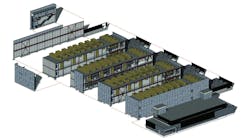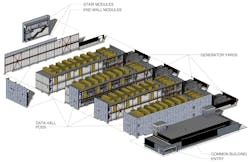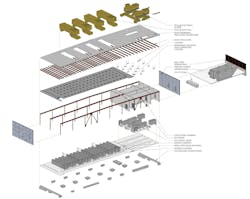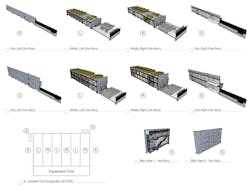BIM-driven prototype turns data centers into a kit of parts
Considering their predominantly functional and technical nature, data centers are becoming as much a product as they are a building. As a data center “product,” there are opportunities for mass customization of assemblies that can lead to higher levels of efficiencies than those that can be attained by an outmoded stick-built/one-off approach to building design.
However, as data center “buildings”—which exist within a real site with a real context and real constraints—the need exists to think of the building as a system of assemblies that can be sensitively arranged to match the unique requirements of a particular location and program.
A promise that building information modeling (BIM) holds is to create a dynamic model of components which can evolve and improve over time.
To take advantage of this promise, Digital Realty commissioned SPARCH to design and model a prototypical, modular data center shell in BIM that was responsive to a range of data center infrastructure solutions that Digital Realty had developed.
As noted by our client, Steve Kundich, AIA, Vice President, Design & Construction with Digital Realty, “BIM was essential for our PBB+ Prototype development, allowing for rapid site master planning and building design. It eliminates most of the conceptual design and design development steps and allows the team to focus on localizing the design to the site and/or customer requirements.”
Rendering depicts a two-story, four-pod prototype assembly with an attached common building
Designed for assembly, this PBB+ (Powered Base Building+) prototype blends the best of prefabrication, modular, and site-built construction. This branded prototype is designed for supply chain optimization while allowing for a range of solutions based on particular site or program requirements.
In terms of supply chain optimization of the major architectural components, this prototype campaign will provide Digital Realty the ability to negotiate a considerable cost savings through long-term, bulk purchasing agreements while allowing for reduced lead times for key components. The major architectural components of the prototype would include roofing, exterior precast panels, sunshades and storefront, entry canopies, and even prefabricated stair modules. In addition, the building’s structural elements have been selected and designed to be simplified, repeatable, and readily available, avoiding long delays for specialty steel sizes and detailing.
From our client’s perspective, these will add up to major savings on the overall project budget and schedule, which equates to a quicker time to market. “The opportunities that BIM affords for off-site fabrication allow for reduced project schedule time and cost savings,” says Kundich. “We are now prefabricating major M&E portions of the project with our suppliers.”
Exploded components diagram of a one-story data hall pod module
Of course, every site is unique, with its own particular opportunities and requirements. The PBB+ prototype is modular in nature, allowing for both single-story and two-story solutions. An office or “common” building module is coupled with a varying number of data hall pod modules, each with the associated electrical and mechanical data center infrastructure that Digital has developed. This planning flexibility allows the prototype to conform to sites of various shapes and sizes throughout our client’s markets, while being flexible enough to accommodate their customers’ unique needs.
Since the PBB+ prototype is documented with BIM, all of Digital Realty’s AE design consultants can use this content to greatly accelerate the documentation of their site-specific projects, reducing the SD and DD phases of the project to just several weeks and allowing the teams to focus on localizing the design to site specific and customer requirements. Ultimately, the CD phases of the project will be reduced as well, as more construction details are developed and refined over time and added to the prototype model.
Portions of this prototype have already been incorporated into several Digital projects currently under way. The savings in cost and time in these case studies are just now being quantified. The goal is to provide a system that can be presented in conjunction with the data center infrastructure solutions that Digital has developed, as either a turn-key solution or as the basis of design for a build-to-suit data center project. Either way, the prototype approach should provide a more rapid and predictable project schedule, both in terms of design and construction, and yield a more cost effective and predictable project budget.
Individual components of one-story and two-story pod configurations
As for next steps, we can imagine setting up and working within a BIM infrastructure where the client's extended ecosystem of consultants/suppliers can continuously and incrementally improve this prototypical model, and do it in a way where the updates become a natural by-product of any given project's workflow.
Specifically, we can envision the development of a Revit Plugin that will, in concert with Revit’s WAN-based Server technology, continuously sync, in real-time, this evolving library of components between all of Digital Realty’s AEC consultant projects.
Similar to the product design analogy referenced above, this hybrid data center “product-building” can continue to evolve with each new “release,” with all of the information contained within this ever-evolving building model, which exists within the BIM infrastructure.
This approach, and the wide network of Digital’s design and vendor partners, should allow for a continual evolution of the design, with greater opportunity for innovation over a one-firm/one-client/one building approach.
We recognize that this represents a dramatic and potentially disruptive departure from the traditional design process. We as architects are ideally suited to participate in and even lead this departure and take advantage of the new opportunities, partnerships, and relationships it promises.



